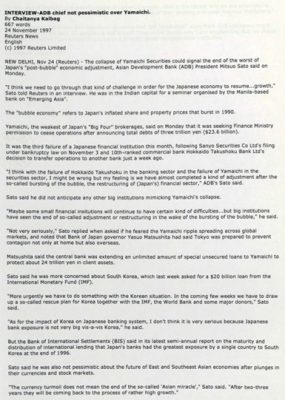INTERVIEW-ADB chief not pessimistic over Yamaichi
[Reuters]
Published date: 24th Nov 1997
24 November 1997
Reuters News
English
(c) 1997 Reuters Limited
NEW DELHI, Nov 24 (Reuters) – The collapse of Yamaichi Securities could signal the end of the worst of Japan’s “post-bubble” economic adjustment, Asian Development Bank (ADB) President Mitsuo Sato said on Monday. “I think we need to go through that kind of challenge in order for the Japanese economy to resume … growth, “Sato told Reuters in an interview. He was in the Indian capital for a seminar organised by the Manila-based bank on “Emerging Asia”. The “bubble economy” refers to Japan’s inflated share and property prices that burst in 1990. Yamaichi, the weakest of Japan’s “Big Four” brokerages, said on Monday that it was seeking Finance Ministry permission to cease operations after announcing total debts of three trillion yen ($23.6 billion). It was the third failure of a Japanese financial institution this month, following Sanyo Securities Co Ltd’s filing under bankruptcy law on November 3 and 10th-ranked commercial bank Hokkaido Takushoku Bank Ltd’s decision to transfer operations to another bank just a week ago. “I think with the failure of Hokkaido Takushoku in the banking sector and the failure of Yamaichi in the securities sector, I might be wrong but my feeling is we have almost completed a kind of adjustment after the so-called bursting of the bubble, the restructuring of (Japan’s) financial sector,” ADB’s Sato said. Sato said he did not anticipate any other big institutions mimicking Yamaichi’s collapse. “Maybe some small financial institutions will continue to have certain kind of difficulties … but big institutions have seen the end of so-called adjustment or restructuring in the wake of the bursting of the bubble,” he said. “Not very seriously,” Sato replied when asked if he feared the Yamaichi ripple spreading across global markets, and noted that Bank of Japan governor Yasuo Matsushita had said Tokyo was prepared to prevent contagion not only at home but also overseas. Matsushita said the central bank was extending an unlimited amount of special unsecured loans to Yamaichi to protect about 24 trillion yen in client assets. Sato said he was more concerned about South Korea, which last week asked for a $20 billion loan from the International Monetary Fund (IMF). “More urgently we have to do something with the Korean situation. In the coming few weeks we have to draw up a so-called rescue plan for Korea together with the IMF, the World Bank and some major donors,” Sato said. “As for the impact of Korea on Japanese banking system, I don’t think it is very serious because Japanese bank exposure is not very big vis-a-vis Korea,” he said. But the Bank of International Settlements (BIS) said in its latest semi-annual report on the maturity and distribution of international lending that Japan’s banks had the greatest exposure by a single country to South Korea at the end of 1996. Sato said he was also not pessimistic about the future of East and Southeast Asian economies after plunges in their currencies and stock markets. “The currency turmoil does not mean the end of the so-called ‘Asian miracle’,” Sato said. “After two-three years they will be coming back to the process of rather high growth.” “The most important lesson we have to learn from Southeast Asian countries is that we have to prepare ourselves for globalisation of financial markets,” Sato said. “In the case of Thailand that was the cause of currency turmoil that is the reason why we are emphasising the need for us to assist them to strengthen the globalisation of their banking and other financial institutions.” Sato said several Southeast and East Asian countries that had “graduated” away from ADB assistance might have to return to the bank for assistance and added: “That is the reason why I am emphasising that we should transform ourselves from project financiers to a broadly-based developmental institution.”






